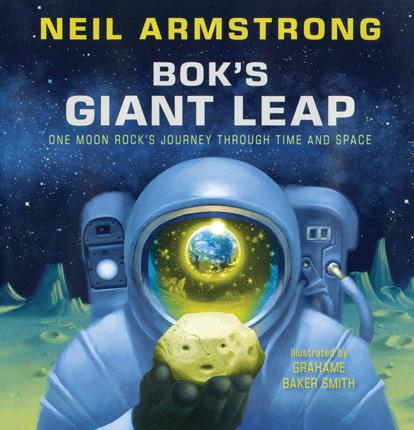| Bok's giant leap : one moon rock's journey through time and space Author: Armstrong, Neil | ||
| Price: $22.58 | ||
Summary:
Based on a speech Neil Armstrong gave upon receiving the moon rock he named Bok, this unique picture book tells the story of how the Earth and the Moon came to be. Includes facts about the Earth and the Moon.
| Illustrator: | Baker-Smith, Grahame |
Reviews:
Kirkus Reviews (08/15/21)
School Library Journal (11/01/21)
Booklist (12/15/21)
Full Text Reviews:
School Library Journal - 11/01/2021 Gr 1–4—Bok, a cute anthropomorphized rock with craters for eyes, has been on the moon from the very beginning. From the violent cosmic collision of its creation to the subsequent cooling, the moon's long geologic history seems to be the focus of the story. But what starts as a study of the moon's history transforms into an overview of life on earth. That shift in direction is unexpected, as Bok's role is downgraded from an active participant through billions of years of geologic change, to a far-off observer to the evolution of life on earth, to a sleeper through human history, until picked up by Neil Armstrong to be taken back to earth for further study. The overview of earth's natural history skips some steps to get to the modern day. As Bok is sleeping, humanity is innovating and inventing, with significant historical figures such as Bessie Coleman and Plato mentioned, although without explanation of their significance. Eventually, humans succeed in putting men on the moon, completing the circle started with the moon's creation billions of years ago. Back matter includes additional information about the moon, earth, and the 1969 moon landing, but no glossary or time line, so the time frames and vocabulary may be confusing to young readers. The illustrations are lovely, creating a clear vision of the cosmic impacts and volcanic explosions of the moon's early days and the strangeness of the earth's early life forms. VERDICT Despite its minor flaws, this exploration of deep time as witnessed by one ancient little moon rock will appeal to budding astronauts, future paleontologists, and burgeoning geologists alike.—Alyssa Annico, Youngstown State Univ., OH - Copyright 2021 Publishers Weekly, Library Journal and/or School Library Journal used with permission.
Booklist - 12/15/2021 In 2006, NASA presented Armstrong with a moon rock, a souvenir of his 1969 lunar stroll. He named the basalt fragment Bok and here, with the proclamation “Rocks remember,” he chronicles its history. Armstrong notes his own early interest in the moon and provides a history of Earth’s satellite from its formation 4.5 billion years ago (following a small planet colliding with Earth) through its turbulent early years (filled with erupting geysers and flowing lava) to its more settled recent existence as observed by Bok himself. Baker-Smith’s art includes ethereal spreads that highlight the drama of cosmic evolution, as well as anthropomorphized views of Bok, who sports human facial features. Dark blues and black are used effectively to convey deep space and ancient settings, while reds and yellows predominate in scenes depicting violent upheaval. Equally appealing are the early Earth scenes, portraying ocean environments, the end of dinosaurs, and the Ice Age, as well as Bok’s retrieval by Armstrong. Appended with spreads detailing lunar history and Armstrong’s career highlights, this makes an appealing STEM read-aloud. - Copyright 2021 Booklist.



